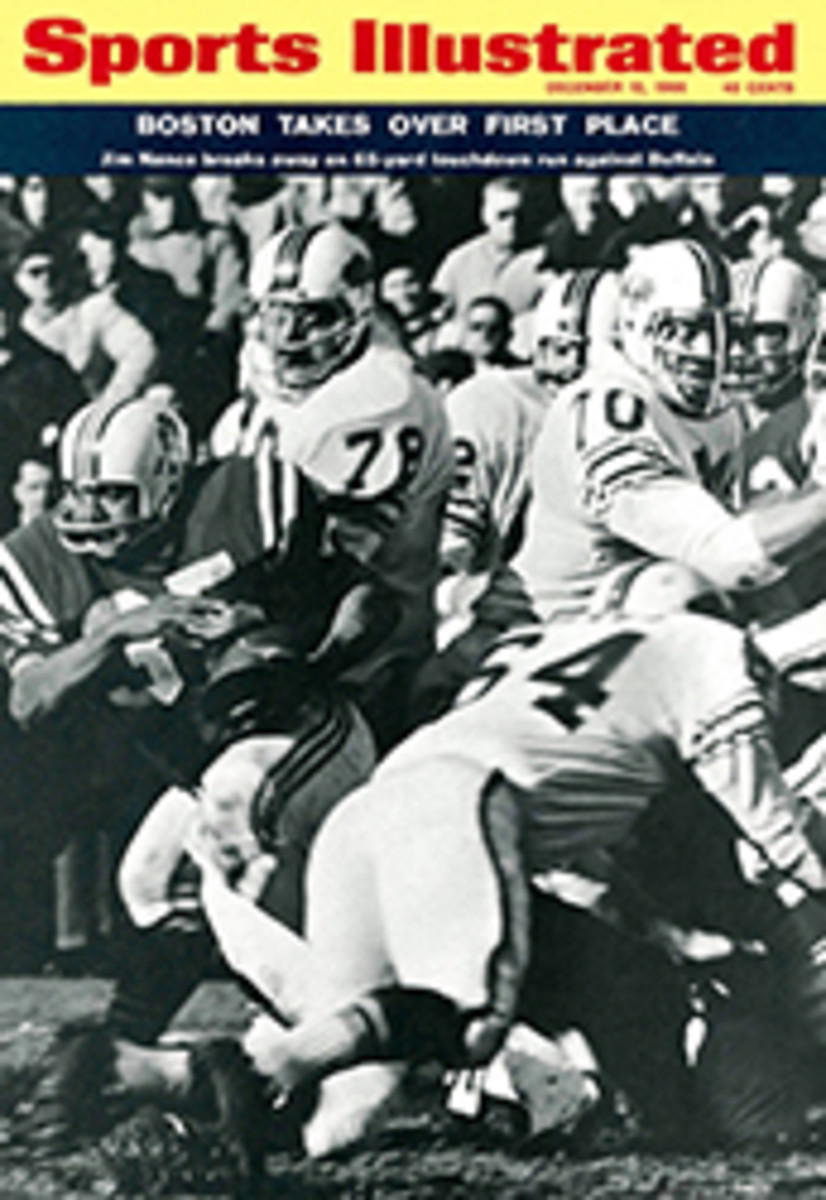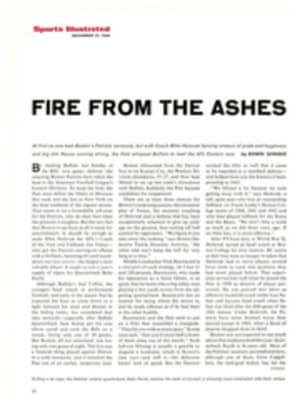
Three was just one too many
If hard work, forethought and careful preparation could always be counted on to breed victory, Harold Eis would have been a cinch to win the third annual World Outboard Championships at Lake Havasu. Defending champion Eis, an automobile-parts dealer from Kansas, believes in taking care—particularly of his boat Salty Cat, a lightweight two-hulled outboard powered by twin 110-hp Mercury motors. Days before most of his competition had even arrived at the Arizona lake where the championships were to be held, Harold was there, spade in hand, digging himself a makeshift dry dock in the hard shale of the lakeshore.
Eis wanted to win this race. He wanted the four-foot trophy offered by the McCulloch company, manufacturers of chain saws and outboard motors, to the first man who could win the race three times, and he wanted the $8,100 in cash that would go to the top boat. That is big money in outboarding.
Unlike hydroplane racing or offshore powerboating, outboarding is a relatively inexpensive sport and the prizes it offers are relatively small. The $25,000 overall purse in the Havasu championship makes it the richest of all outboard races, and its prizes can be won by engines and hulls that are far cheaper than those contesting for inboard honors.
Although many of the boats at Havasu bore about as much relationship to Junior's little runabout as Ben Hur's racing chariot did to the surrey with the fringe on top, outboard racing still enjoys an identification with the man (or woman) who owns a boat and motor for weekend fun. As a result, the fields in outboard races tend to be far larger than those in most other boating events. There were more than 120 crews at Havasu, for instance, eager to contest Harold for his cup and his prize money.
Most of the 120 arrived only a day or so before the race began, and all, except Harold, meekly established their pits where they were told. Eis was different. Eis wins races and he knows the most important factor in a two-day marathon (two hours on Saturday, four on Sunday) is preparation—and preparation for the worst. As he saw it, if he needed to change one of his engines in a hurry he could speed up the process by digging a canal and burying his trailer in the canal's bed to form a sort of do-it-yourself dry dock. Then, if he should have trouble, he could simply run his boat onto the trailer, pull out the bad engine, replace it with one of the two spares he always carries in his truck and get going again in seconds. Eis originally wanted to establish his pits right below race headquarters at the Nautical Inn, within easy reach of a power line for his lights and tools. But the spot he wanted lay outside the bounds of the official pit area, and after some futile give-and-take with an adamant official who said he must pit where everyone else pitted. Eis capitulated and went to work on his private harbor.
All afternoon he and his Nebraskan crewman, Mike Hynek, toiled in the ice-cold Colorado River water. They filled sandbags to support the trailer's wheels and built a levee. At dusk on Wednesday evening they were still at it. Mrs. Eis, who doubles as Harold's pit boss, tried to get him out of the water. "You gonna catch pneumonia wading around out there," she cried. "I hope not," replied Harold, more interested in the race than a little lung trouble.
By the time Eis, still miraculously free of pneumonia, had finished his digging, some of the other drivers had begun to arrive from three countries and more than a score of states.
There was Jan Schoonover from Lima, Ohio, another driver with 110 hp Mercs on his boat. Schoonover's boat, which looks more like a Batmobile, holds his class world record of 96.008 mph. Obviously, it could do 100 mph on any of the straights on Havasu's four-mile-long, boomerang-shaped course. Other drivers out to wreck Eis's winning streak were Joe Stevens Sr. from Manteca, Calif., the winner of 19 out of 20 races; Floyd C. Murton from Hot Springs, Ark., with a record of 11 wins in seven race meets; Lou Cooley, a radio traffic monitor from Station KXOK, St. Louis, who gives his radio audience a running account of the race while driving his boat; and tall John Merritt, a gas-station operator from Westchester, Calif., who would drive the biggest boat in the race and had arrived at Havasu fresh from a victory in the grueling Salton Sea 500-mile marathon.
The man Eis feared most of all, however, was Bill Hill Jr. from Cullman, Ala., driving a Power Cat with not two but three big Mercs. "From what I seen yet," said Eis, who had spent all day Thursday trying to bait his rivals into pickup races that would burn up their engines before the marathon began, "Bill's my favorite to win."
McCulloch Properties Inc. likes to think of its Lake Havasu City as a kind of lakeside Palm Springs. By Friday night it looked more like Coney Island overrun by a mechanics' convention. On the shore a blaring carnival whirled and swooped in a miasma of cotton candy and canned music. Overlaying it were the sounds of portable generators chattering out power for trailer dwellers, and the tortured howl of someone testing his outboard engine.
On Saturday morning the weather continued cool, dry and clear. As 2 p.m. approached, the pit area buzzed with speculation: Who would be in front after the first day's two-hour run? Eis with his Mercs? One of the big three-engined boats like Bill Hill's or the yellow Raysoncraft driven by Don Harper of Norwalk, Calif.? One of the outnumbered Evinrudes sponsored by Doc Jones of Phoenix and driven by such veterans as Ted May of Long Beach, Calif.? No one was more interested in the answer than Harold Eis.
The race began with a roar at 2 sharp. Everyone was there, everyone but Harold. "I think he's playing it cool," blared the P.A. announcer. "He's hanging back to run in clear water." And that is precisely what Eis had in mind. But his pit boss, Mrs. Eis, stopwatch in hand, deep in a set of hip boots, was worried that he might have delayed his start too long. As the race organized itself into a continuous ribbon of boats chasing each other around the four-mile course, Eis began to move on the leaders. His times dropped from 5 minutes 20 seconds in the eighth lap to 4 minutes 37 seconds in the 16th. But way out front, seemingly beyond reach as the day's deadline of 4 o'clock neared, were Ted May running second in No. T-2 and Bill Hill running smoothly in first place in that Power Cat that Eis feared so much.
At the end of the first day's racing, the race committee, for reasons known only to itself, announced that May was leading, then changed its mind after a long, wet meeting and announced that the leader wasn't May at all but Hill.
Hill spent the evening of Saturday repairing the wear and tear his first-day lead had inflicted on his sleek hull and three fat Mercs. Deep in their pits, Harold Eis and Company meditated over what had to be done on Sunday to beat Hill, May and the rest. Harold had been robbed of one lap by a group of myopic scorers and was three laps behind the leader. Two laps he figured he could make up—but three? He didn't know. The final four hours would tell the most when speedy pit stops could spell the difference. While the competition slept, Eis and family practiced filling his tanks until they got the time down to just over a minute.
On Sunday morning luck seemed to be with Harold. He made a picture-book start, right next to the pace boat and flying. In 15 minutes he had made up almost every lap he owed the leaders. Then trouble. He blew an engine. Traveling at upwards of 75 mph, with only one good engine, he still could stay with the boats in front but couldn't catch them. He had no choice but to come into the pits and change the sick port engine. No one else in the whole race was prepared for a quick change of engines the way Eis was. His face whipcord tight, Eis drove his boat onto the trailer in the harbor he had so diligently built. With the bow line tied to a winch, he hopped out of the boat's driving seat and, still dressed in life jacket but without his helmet, leaped into the truck hitched to the trailer and jerked his sick boat clear out of the water. By now Helen Eis and Harold's uncle and aunt had all the right tools ready, and the job of removing the bad engine began. Hardly 10 minutes later a new engine had replaced the old and Eis was back on the water. The only words he had said during the whole operation were: "No, the wrench with the yellow handle."
"If I had to change an engine like that it'd take me a week," said an amazed bystander.
But it was all for nothing. After one more lap poor Harold was back in the pits with a broken steering gear. "We're all through," he said. "No, we're not," insisted Helen, bravely setting to work on a jury rig. But Harold was right. With the steering gear repaired in helter-skelter style, he started out again, only to find more trouble. On Lake Havasu it seemed that all the luck that accompanied his careful preparations in years of racing had suddenly deserted him and when the race ended he was in 20th place. His only comfort was that Hill and May, both plagued with engine trouble, finished 24th and 60th respectively.
In contrast, Harper's big 106 made only a single pit stop as it breezed along at an average 59 mph to win the race. "It was like going for a ride in a Cadillac on a Sunday afternoon," said Relief Driver Dutch Blazer.
PHOTO
THE WINNING BOAT (TOP RIGHT) ROARS AROUND A TIGHT TURN WELL BACK IN THE PACK ON THE FIRST DAY OF THE MARATHON

